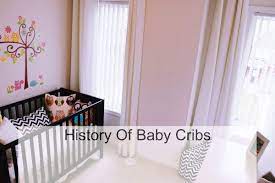As a parent, I know how important baby cribs are for the safety and comfort of our little ones. But have you ever wondered about the history of baby cribs? How did we get from Moses’ basket to the cribs we have today? It turns out that the history of baby cribs is quite fascinating and spans centuries.

The first baby cribs were not even cribs as we know them today. In fact, parents used to lay their babies down in bundles of cloth or even baskets. It wasn’t until between the 1600s and 1800s that the first crib-like structures were invented. Even then, people used hollowed-out logs for this purpose, and rarely did they cradle a newborn for a full night. As time passed, cribs evolved to become more comfortable, safe, and convenient for parents. Today, we have a wide range of cribs to choose from, including convertible cribs, portable cribs, and even smart cribs that track your baby’s sleep.
In this article, we’ll take a closer look at the history of baby cribs, from the earliest forms to the modern-day designs. We’ll explore how cribs have evolved over time and the different materials and styles that have been used. By the end of this article, you’ll have a better understanding of the humble beginnings of baby cribs and how they have become an essential part of every nursery.
Origins of Baby Cribs

As I researched the history of baby cribs, I found that the first cribs were not actually cribs as we know them today. Parents used to lay their babies down in bundles of cloth or even baskets. It wasn’t until between the 1600s and 1800s that the first crib-like structure was invented. Even then, people used hollowed-out logs for this purpose, and rarely did they cradle a newborn for a full night.
As time went on, cribs evolved. In the early 1900s, parents used simple pine rockers to lull their babies to sleep. Later on, cribs were made from metal and had a drop side for easy access. However, these cribs were not very safe and could easily trap or injure a baby.
In the 1970s, the U.S. government began regulating the manufacturing of cribs to make them safer. This led to the creation of cribs with slats that were spaced no more than 2 3/8 inches apart and cribs with fixed sides that were more secure.
Today, cribs are designed with safety in mind and come in a variety of styles and designs. Some cribs can even be converted into toddler beds or daybeds, making them a practical investment for parents.
Evolution of Design and Safety Standards

As baby cribs evolved over time, design features and safety standards were added to ensure the safety and comfort of infants. In this section, I will discuss the evolution of design and safety standards of baby cribs.
Early Design Features
The earliest baby cribs were simple baskets made of woven reeds or wood. As time went on, cribs became more elaborate and were made of various materials such as iron, brass, and wood. However, early cribs lacked safety features, and infants were at risk of injury or suffocation.
20th Century Safety Reforms
In the 20th century, safety reforms were introduced to prevent infant injuries and deaths. In the 1920s, baby “cages” became popular, but they lacked safety precautions. In the 1950s, cribs started to resemble modern ones, but safety standards were still not in place. In 1973, the U.S. Consumer Product Safety Commission developed the first federal crib safety standards, which included slat spacing, corner post height, and mattress support.
Contemporary Safety Regulations
Today, baby cribs must meet the latest safety standards, which include strict guidelines for slat spacing, corner post height, and mattress support. Cribs must also be made of safe materials and be free of lead-based paint. Additionally, the Juvenile Products Manufacturers Association (JPMA) certifies cribs that meet their safety standards.
Cultural Significance of Cribs

Cribs have played a significant role in different cultures throughout history. From literature to art, cribs have been depicted in various forms. In this section, I will discuss the cultural significance of cribs in literature and art, as well as the symbolism of cribs in different societies.
Cribs in Literature and Art
Cribs have been depicted in literature and art for centuries. In Renaissance paintings, the nativity scene often includes a crib, representing the birthplace of Jesus. In literature, cribs have been mentioned in various works. For example, in Charles Dickens’ “Oliver Twist,” the protagonist is born in a workhouse and sleeps in a crib made of old coffin boards. Cribs have also been featured in children’s books, such as “Goodnight Moon” by Margaret Wise Brown.
Symbolism in Different Societies
Cribs have different symbolic meanings in different societies. In some cultures, cribs are seen as a symbol of new life and hope. For example, in Japan, the baby’s first nap in the crib is considered a significant event, and the baby is dressed in a special outfit for the occasion. In some African cultures, cribs are decorated with bright colors and patterns to ward off evil spirits.
In some cultures, cribs are also used as a way to connect with ancestors. For example, in some Native American cultures, cribs are made of cedar wood, which is believed to have healing properties. The cedar crib is passed down from generation to generation, and each new baby is believed to be connected to their ancestors through the crib.
Technological Advancements in Cribs

Incorporation of Electronics
With the advancement of technology, cribs have become more sophisticated and feature-packed. Nowadays, cribs come equipped with various electronic features such as music players, nightlights, and even built-in cameras. These features help parents keep an eye on their babies and soothe them when they cry. The music players can play lullabies or white noise to help the baby sleep peacefully. The nightlights provide a soft glow that helps the baby feel secure and comfortable.
Smart Cribs and Automation
In recent years, smart cribs have become increasingly popular. These cribs come equipped with sensors that monitor the baby’s movement and breathing. They can detect if the baby is awake or asleep and adjust the crib’s position accordingly. Some smart cribs can even simulate the motion of a car or a swing to help the baby fall asleep faster. The sensors can also detect if the baby is in distress and alert the parents via a smartphone app.
Furthermore, some cribs come equipped with automation features that make life easier for parents. For instance, some cribs can adjust the height of the mattress, making it easier for parents to put the baby in and take them out of the crib. Some cribs can also fold up for easy storage or transport. These features make cribs more convenient and user-friendly.
Global Market and Industry Trends
As I researched the history of baby cribs, I also looked into the current state of the global market and industry trends. Here are some of the key findings:
Leading Manufacturers
According to my research, some of the leading manufacturers of baby cribs include Delta Children, Storkcraft, Graco, and DaVinci. These companies offer a wide range of cribs in different styles and price points, from basic models to high-end designs. In addition, many of these manufacturers also offer other baby furniture and accessories, such as dressers, changing tables, and gliders.
Economic Impact
The baby cribs market has a significant economic impact, both in the United States and around the world. According to a report by Grand View Research, the global baby cribs and cots market is expected to be valued at USD 1.67 billion by 2025 and is expected to grow at a compound annual growth rate (CAGR) of 4.6% during the forecast period. This growth is driven by factors such as rising birth rates, increasing disposable income, and growing awareness of the importance of safe sleep practices for infants.
In addition, the production and sale of baby cribs and other baby products support a large number of jobs in manufacturing, retail, and related industries. For example, a report by the National Retail Federation found that the baby products industry supports over 700,000 jobs in the United States alone. This includes not only jobs in manufacturing and retail, but also in areas such as marketing, logistics, and customer service.
Environmental and Health Considerations
As a parent, I am always concerned about the safety and well-being of my child. When it comes to choosing a baby crib, environmental and health considerations are important factors to keep in mind. Here are a few things to consider:
Use of Sustainable Materials
Choosing a baby crib made from sustainable materials is a great way to reduce your carbon footprint and protect the environment. Some popular sustainable materials include bamboo, reclaimed wood, and FSC-certified wood. Not only are these materials eco-friendly, but they also tend to be more durable and long-lasting than traditional materials.
Non-Toxic Paints and Finishes
When it comes to painting or finishing your baby’s crib, it is important to choose non-toxic options to avoid exposing your baby to harmful chemicals. Look for cribs that use water-based paints or finishes that are free from volatile organic compounds (VOCs). These options are better for your baby’s health and the environment.
Future of Baby Cribs
As a parent, I always want the best for my baby, and I know that other parents feel the same way. That’s why I’m excited about the future of baby cribs, which promises to bring even more innovative designs and safety improvements to the market.
Innovative Designs on the Horizon
One of the most exciting trends in baby cribs is the move towards eco-friendly and sustainable materials. Manufacturers are starting to use materials like bamboo, which is durable, renewable, and has natural antimicrobial properties. Some cribs are even made from recycled plastic or other materials that would otherwise end up in a landfill.
Another trend is the incorporation of technology into baby cribs. Some cribs now come with built-in monitors that track your baby’s breathing, heart rate, and sleep patterns. Others have built-in white noise machines or speakers that can play lullabies or other calming sounds.
Predictions for Safety Improvements
Safety is always a top concern for parents when it comes to baby cribs, and I’m happy to say that manufacturers are constantly working to improve the safety of their products. In the future, I predict that we’ll see even more safety features incorporated into baby cribs.
For example, some cribs may come with sensors that detect when a baby is in the crib and automatically adjust the temperature or humidity levels to ensure optimal comfort. Other cribs may have built-in air purifiers or filters that remove allergens and other irritants from the air.

